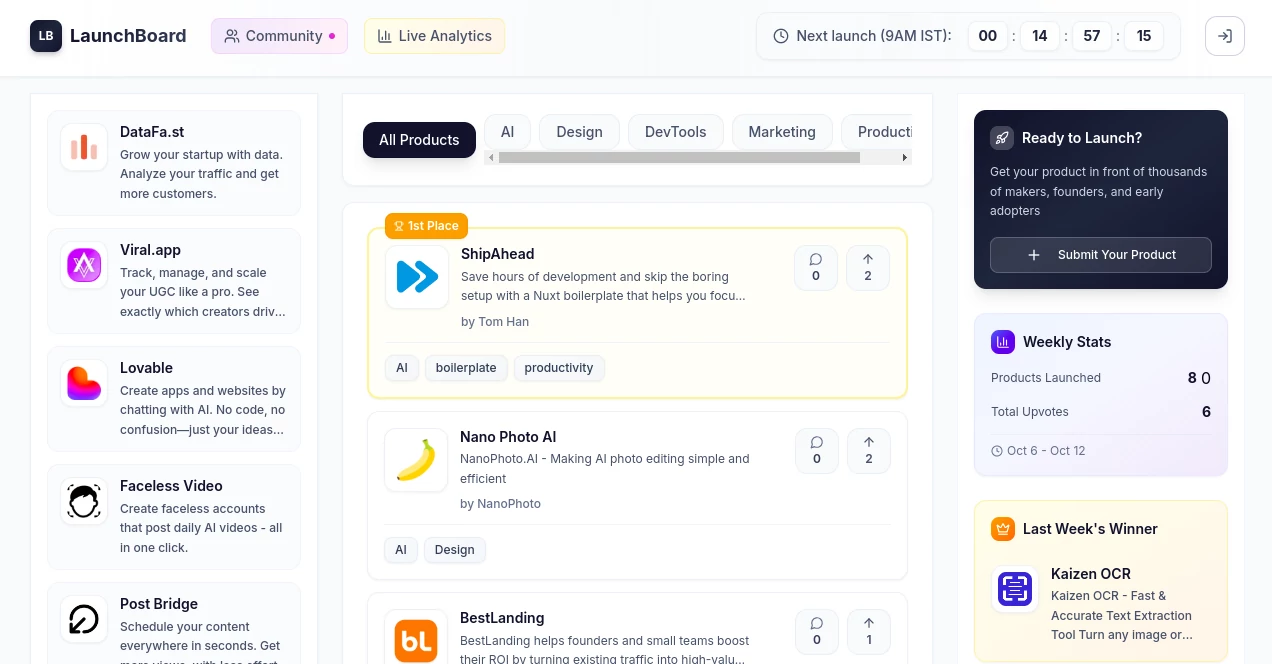LaunchBoard
Launch Products with Confidence

What is LaunchBoard?
Launchboard serves as a streamlined hub for teams rolling out new features, keeping everyone looped in from brainstorm to rollout. This platform turns the scatter of updates into a clear trail, blending announcements with feedback loops to make launches feel less like leaps and more like steps. Builders and marketers alike lean on it to sync efforts, spot hitches early, and celebrate wins without the usual chaos.
Introduction
Launchboard sprang from the trenches of fast-moving dev crews who found themselves buried under email threads and Slack pings just to keep launches on track. A handful of engineers pieced it together a couple years ago, pulling in lessons from their own fumbled rollouts to craft something that just works. Word got around quick in indie circles and startup alleys, where folks started swapping stories of how it shaved weeks off prep time and cut misfires in half. At its heart, it's about that quiet shift from reactive firefighting to proactive planning, letting teams breathe easier as they push boundaries without the fear of blind spots.
Key Features
User Interface
The landing page hits you with a central feed that scrolls like a shared journal, each entry popping with color-coded stages from draft to done. Side panels unfold for quick adds, like tagging a teammate or pinning a deadline, all in a layout that mirrors your workflow without extra fluff. Mobile tweaks make it pocket-ready, so you can glance at progress during coffee runs or tag in from the road.
Accuracy & Performance
Updates sync in real time, flagging overlaps or gaps before they snowball, with timelines that hold true even under heavy team traffic. It nails the details, like auto-linking related threads or surfacing forgotten tasks, often catching what slips past in group chats. Users note how it keeps the pace steady, churning through notifications without bogging down, so focus stays on the build rather than the busywork.
Capabilities
From sketching rough plans with drag-and-drop milestones to weaving in beta tests and rollout checklists, it covers the full arc of getting something live. Integrations hook into your stack, pulling metrics or pushing alerts to where your crew hangs out. Custom views let you slice data by role or phase, while analytics peek at past launches to sharpen the next one, turning hindsight into upfront smarts.
Security & Privacy
Plans lock down with role-based peeks, so only those in the loop see the full picture, and audit trails track every nudge without cluttering your view. It sticks to solid standards for data handling, keeping sensitive specs encrypted and access logs tidy. Teams trust it for handling the nitty-gritty without leaks, especially when juggling external testers or partner inputs.
Use Cases
Indie devs map out app drops, coordinating code pushes with user teases to hit app stores smooth. Marketing squads orchestrate campaigns, syncing emails with feature reveals for timed punches. Remote outfits use it to bridge time zones, with shared boards that keep far-flung contributors in step. Even consultants adapt it for client handoffs, turning project wraps into seamless transitions.
Pros and Cons
Pros:
- Glues teams together without drowning in messages.
- Spotlights risks early, dodging last-minute scrambles.
- Pulls in tools you already use, no big switches.
Cons:
- Setup takes a beat to tailor just so.
- Free layer caps at small-scale runs.
- Heavy custom fields might nudge toward upgrades.
Pricing Plans
Free tier covers basics for up to five users and a handful of active boards, ideal for side gigs. Pro kicks in at twenty bucks monthly for unlimited everything and deeper hooks, while teams scale to sixty with admin tools and priority bumps. Annual saves a slice, and you can trial the full suite for two weeks to see if it clicks.
How to Use Launchboard
Jump in with a quick sign-up, then spin up your first board by naming the project and dropping in key dates. Rally your folks with invites, flesh out steps with notes or files, and link your repos for auto-updates. As things move, check the overview for bottlenecks, tweak paths on the fly, and wrap with a post-mortem that feeds the next round. It's all about that rhythm—set it once, then let it roll.
Comparison with Similar Tools
Against sprawling project trackers, Launchboard hones in on the launch dance, skipping the overload for laser focus, though those might suit broader ops better. Where chat apps scatter updates, it corrals them into stories that stick, but purists could miss the casual ping. It carves out space for product pushes where others spread thin, blending ease with edge.
Conclusion
Launchboard quiets the storm of shipping software, handing teams a compass for calmer waters and crisper deliveries. It honors the thrill of building by smoothing the rough edges, letting ideas land with impact. As more outfits chase that perfect drop, this board keeps proving its worth, one steady rollout at a time.
Frequently Asked Questions (FAQ)
Can I link it to my code repo?
Yep, hooks into Git flavors for pulls and pushes that update live.
How many boards can I run free?
A few active ones, with archives for the rest to keep things tidy.
Does it work for non-tech launches?
Sure, adapts to events or campaigns with the same steady flow.
What's the team limit on starter plans?
Small crews fit fine, scaling up as you grow the circle.
Any offline access?
Core views sync later, but real magic shines online for shares.
AI Task Management , AI Team Collaboration , AI Workflow Management , AI Project Management .
These classifications represent its core capabilities and areas of application. For related tools, explore the linked categories above.
LaunchBoard details
Pricing
- Free
Apps
- Web Tools
Categories
LaunchBoard Alternatives Product
Nifty
ClearWork
Jamy.ai | Au…
Motion
Candidate Sc…
Miro
Instantly Id…
4ga Boards
Zapier

















